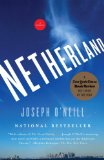Summary | Excerpt | Reading Guide | Reviews | Beyond the Book | Readalikes | Genres & Themes | Author Bio

A Novel
by Joseph O'Neill
The reporter says, “This is about Kham, ah, Khamraj Ramkissoon ... ?”
“Chuck,” I say, sitting down at the kitchen table. “It’s Chuck Ramkissoon.”
She tells me that Chuck’s “remains” have been found in the Gowanus Canal. There were handcuffs around his wrists and evidently he was the victim of a murder.
I don’t say anything. It seems to me this woman has told an obvious lie and that if I think about it long enough a rebuttal will come to me.
Her voice says, “Did you know him well?” When I don’t answer, she says, “It says somewhere you were his business partner.”
“That’s not accurate,” I say.
“But you were in business together, right? That’s what my note says.”
“No,” I say. “You’ve been misinformed. He was just a friend.”
She says, “Oh—OK.” There is a tapping of a keyboard and a hiatus.
“So—is there anything you can tell me about his milieu?”
“His milieu?” I say, startled into correcting her mooing pronunciation.
“Well, you know—who he hung out with, what kind of trouble he might have gotten himself into, any shady characters ...” She adds with a faint laugh, “It is kind of unusual, what happened.”
I realize that I’m upset, even angry.
“Yes,” I finally say. “You have quite a story on your hands.”
The next day a small piece runs in the Metro section. It has been established that Chuck Ramkissoon’s body lay in the water by the Home Depot building for over two years, among crabs and car tires and shopping carts, until a so-called urban diver made a “macabre discovery” while filming a school of striped bass. Over the next week there is a trickle of follow-up items, none of them informative. But apparently it is interesting to readers, and reassuring to certain traditionalists, that the Gowanus Canal can still turn up a murder victim. There’s death in the old girl yet, as one commentator wittily puts it.
The night we receive the news, Rachel, in bed next to me, asks, “So who’s this man?” When I don’t immediately answer, she puts down her book.
“Oh,” I say, “I’m sure I’ve told you about him. A cricket guy I used to know. A guy from Brooklyn.”
She repeats after me, “Chuck Ramkissoon?”
Her voice contains an amused note I don’t like. I roll away onto one shoulder and close my eyes. “Yes,” I say. “Chuck Ramkissoon.”
Chuck and I met for the first time in August 2002. I was playing cricket at Randolph Walker Park, in Staten Island, and Chuck was present as one of the two independent umpires who gave their services in return for a fifty-dollar honorarium. The day was thick as a jelly, with a hot, glassy atmosphere and no wind, not even a breeze from the Kill of Kull, which flows less than two hundred yards from Walker Park and separates Staten Island from New Jersey. Far away, in the south, was the mumbling of thunder. It was the kind of barbarously sticky American afternoon that made me yearn for the shadows cast by scooting summer clouds in northern Europe, yearn even for those days when you play cricket wearing two sweaters under a cold sky patched here and there by a blue tatter—enough to make a sailor’s pants, as my mother used to say.
By the standards I brought to it, Walker Park was a very poor place for cricket. The playing area was, and I am sure still is, half the size of a regulation cricket field. The outfield is uneven and always overgrown, even when cut (once, chasing a ball, I nearly tripped over a hidden and, to cricketers, ominous duck), and whereas proper cricket, as some might call it, is played on a grass wicket, the pitch at Walker Park is made of clay, not turf, and must be covered with coconut matting; moreover the clay is pale sandy baseball clay, not red cricket clay, and its bounce cannot be counted on to stay true for long; and to the extent that it is true, it lacks variety and complexity. (Wickets consisting of earth and grass are rich with possibility: only they can fully challenge and reward a bowler’s repertoire of cutters and spinners and bouncers and seamers, and only these, in turn, can bring out and fully test a batsman’s repertoire of defensive and attacking strokes, not to mention his mental powers.) There is another problem. Large trees—pin oaks, red oaks, sweetgums, and American linden trees—clutter the fringes of Walker Park. Any part of these trees, even the smallest hanging leaf, must be treated as part of the boundary, and this brings randomness into the game. Often a ball will roll between the tree trunks, and the fielder running after it will partially disappear, so that when he reemerges, ball in hand, a shouting match will start up about exactly what happened.
Excerpted from Netherland by Joseph O'Neill Copyright © 2008 by Joseph O'Neill. Excerpted by permission of Pantheon, a division of Random House, Inc. All rights reserved. No part of this excerpt may be reproduced or reprinted without permission in writing from the publisher.




Knowledge is of two kinds. We know a subject ourselves, or we know where we can find information on it.
Click Here to find out who said this, as well as discovering other famous literary quotes!
Your guide toexceptional books
BookBrowse seeks out and recommends the best in contemporary fiction and nonfiction—books that not only engage and entertain but also deepen our understanding of ourselves and the world around us.